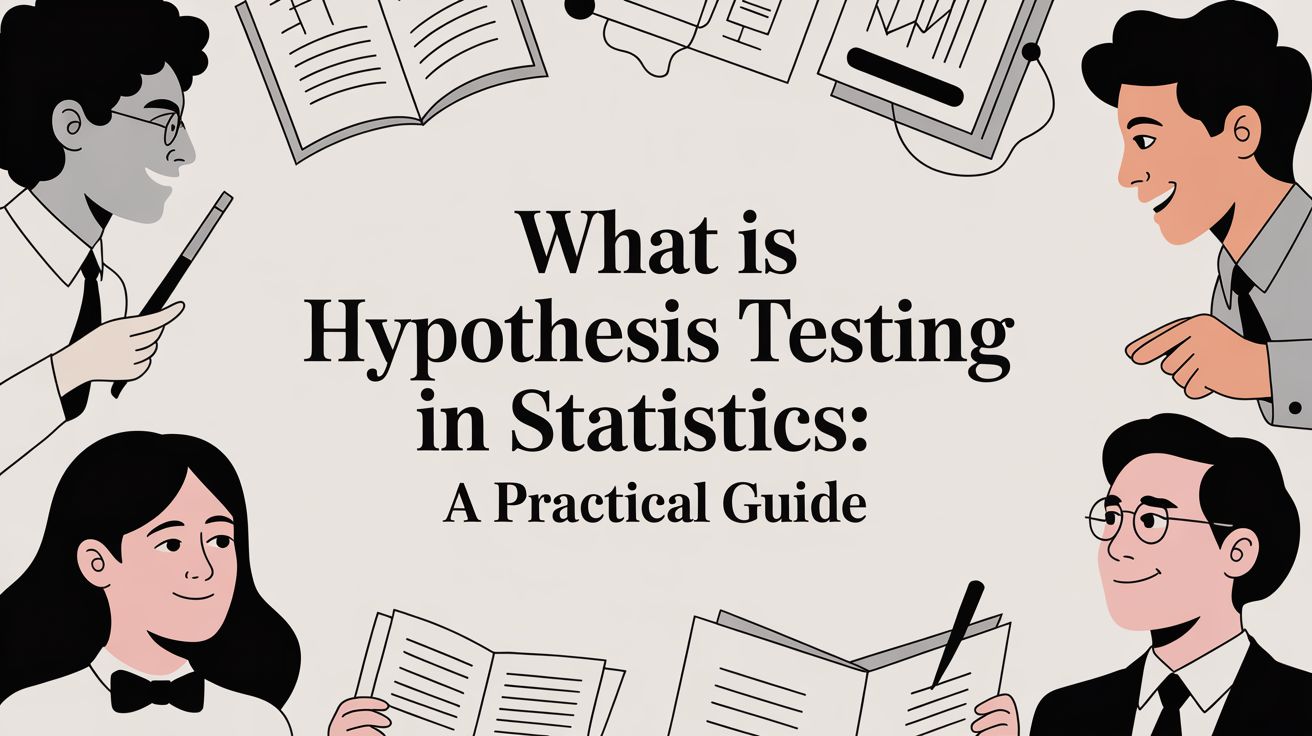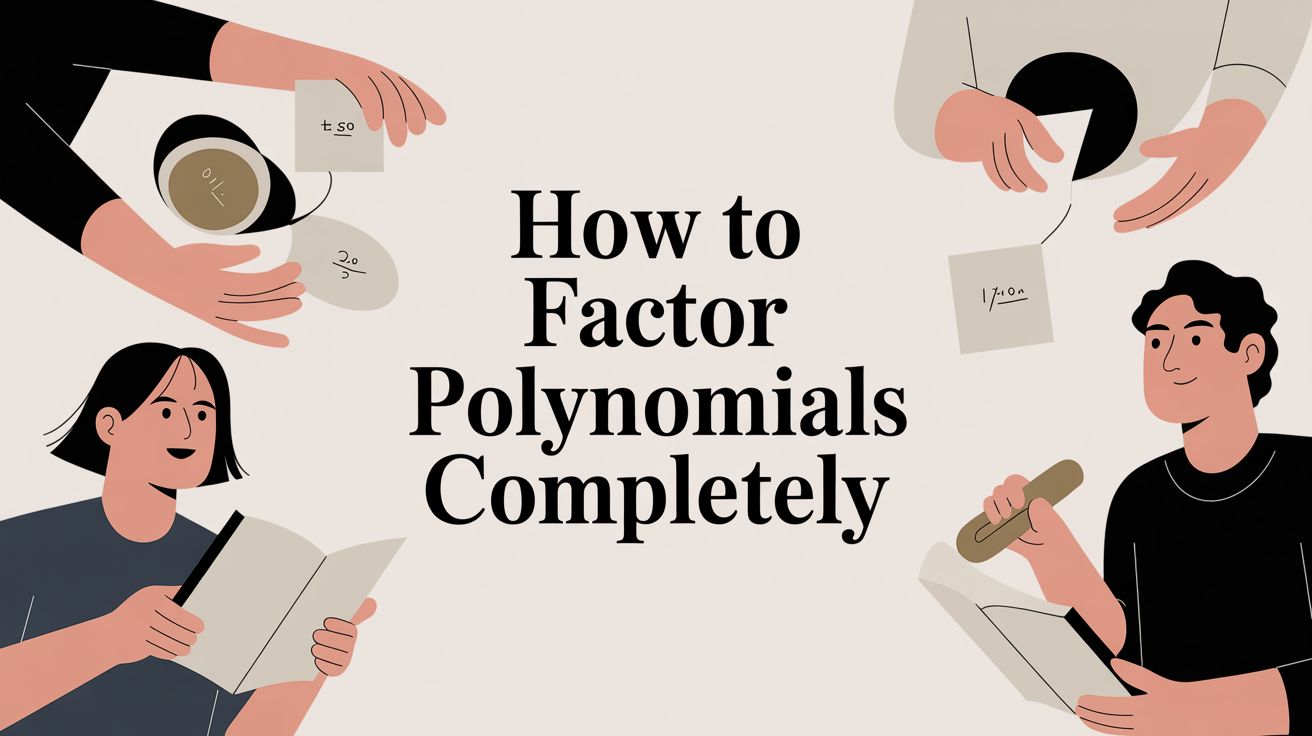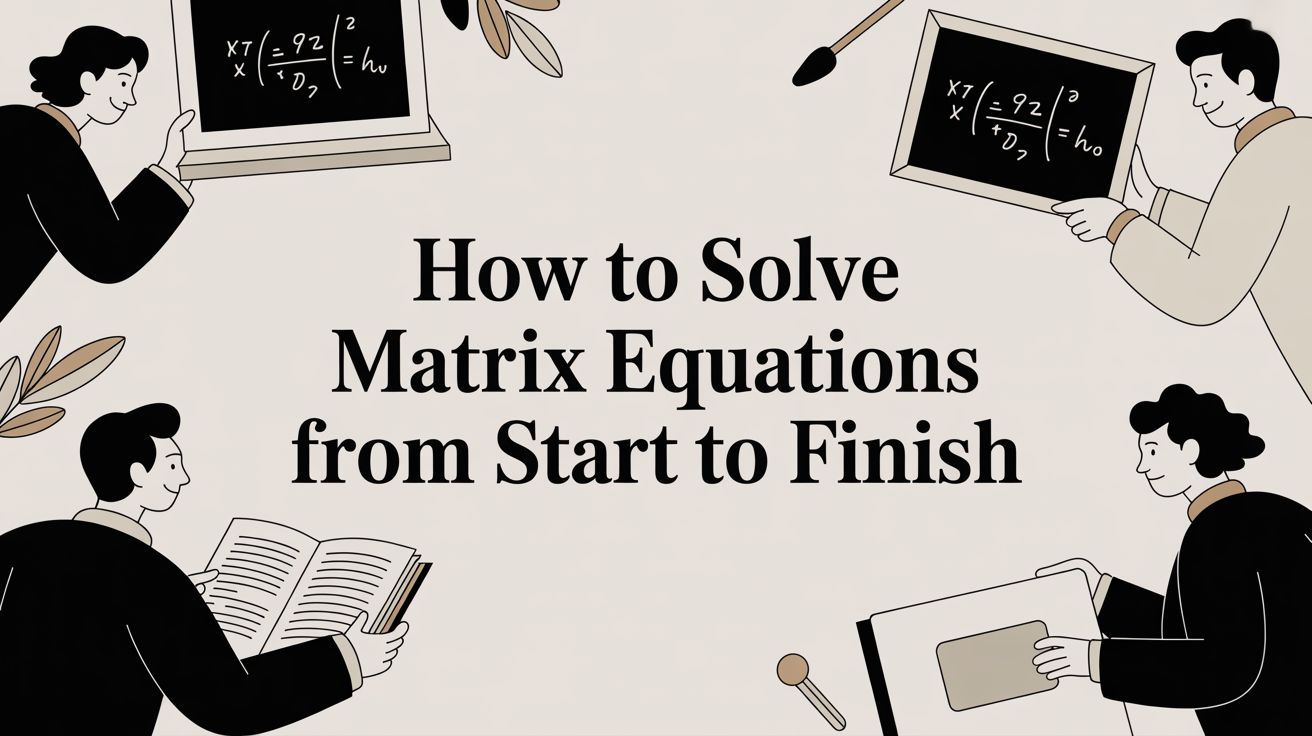How to Study a Textbook: Smart Tips for Retention and Grades
Discover how to study a textbook with active recall, smart notes, and proven strategies to boost memory and ace exams.
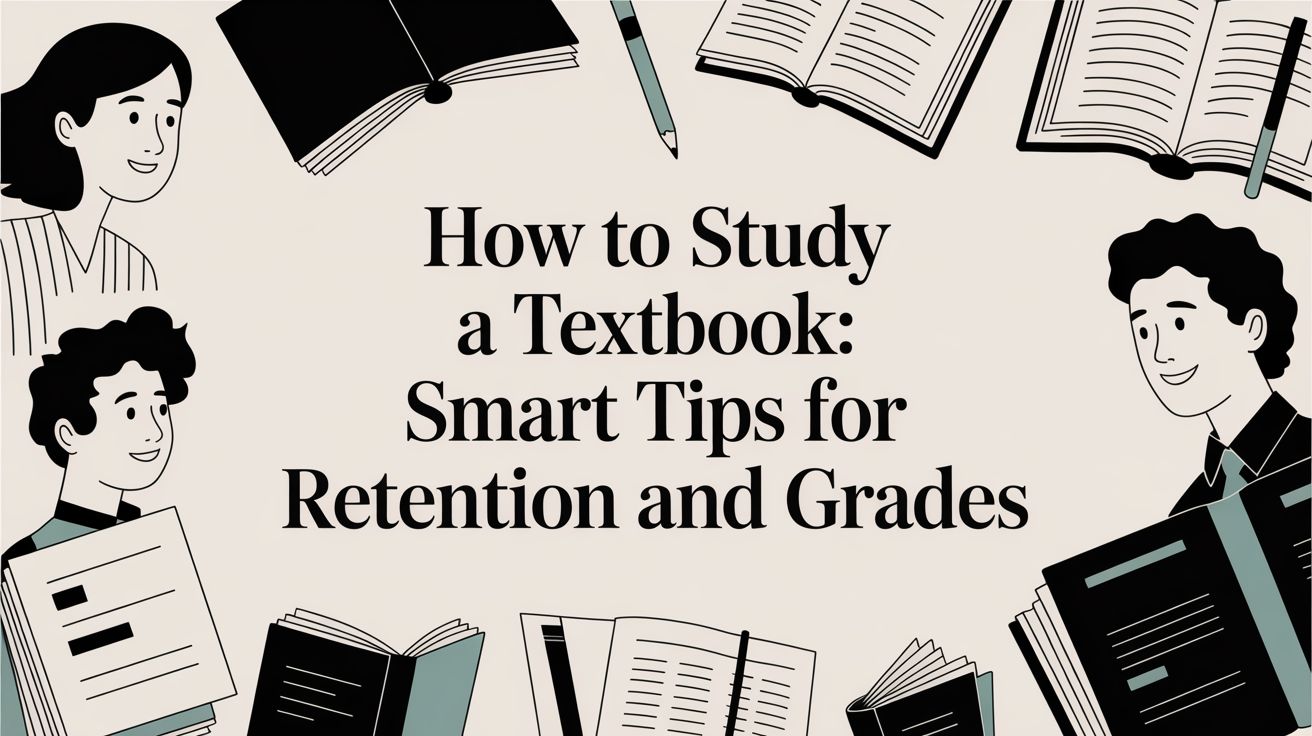
If your go-to study method involves a textbook and a highlighter, you're not alone. We’ve all been there, diligently coloring page after page, feeling like we’re making progress. But when the test comes, that highlighted text feels like a foreign language.
The hard truth is that highlighting, underlining, and simply rereading are passive activities. They create an "illusion of competence" — you recognize the material, but you can't recall or apply it. It feels productive, but it doesn't build real, lasting knowledge. The secret to actually learning from a textbook is to switch to active studying.
Move Beyond Highlighting and Start Active Studying
Active studying means you stop being a passive spectator and start wrestling with the material. You question it, connect it to what you already know, and force your brain to work. It’s about treating the textbook not as a script to be memorized, but as a conversation to be had.
This might feel slower at first, but the payoff in comprehension and retention is huge.
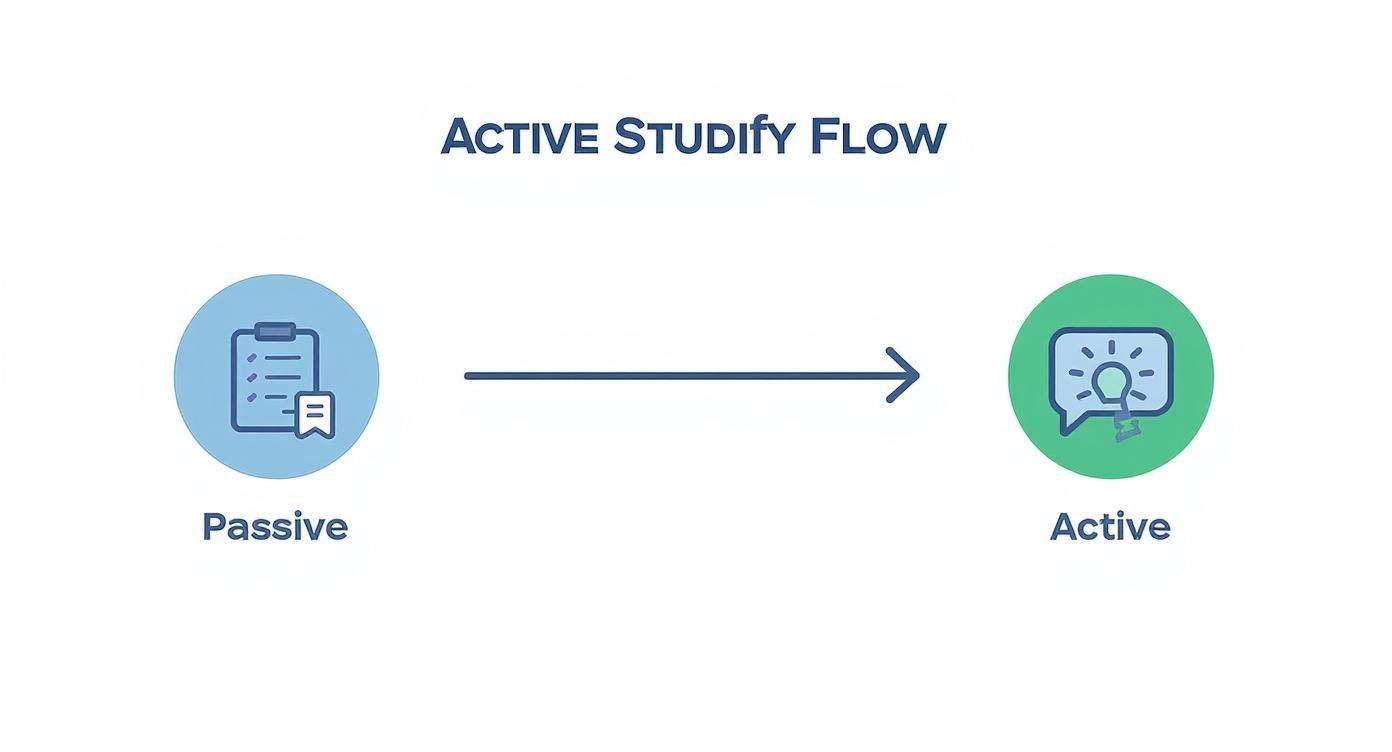
The goal is to deconstruct the information and then rebuild it in your own mind, which creates much stronger neural pathways for memory.
The Problem with Passive Learning
Passive learning is popular because it's easy. It requires very little mental effort. Highlighting a sentence doesn't force you to understand its context or implications; you're just flagging something that seems important.
Research consistently shows these low-effort strategies do almost nothing for long-term memory. To understand why, look into Cognitive Load Theory. It explains how our brains process information, and it makes a clear case for why active, engaged learning is superior for managing that cognitive load effectively.
What Active Studying Looks Like
So, what does it actually mean to be an "active" studier? It’s a hands-on approach that turns you into a participant in your own learning.
Here are the core components:
- Previewing: Skim the chapter first. Look at headings, summaries, and images to create a mental roadmap before you read a single paragraph.
- Questioning: Turn section headings and key terms into questions. This gives your reading a purpose—you're now hunting for answers.
- Annotating: Scribble in the margins. Don't just highlight; write down questions, summarize a paragraph in your own words, or connect an idea to something from a previous chapter.
- Summarizing: After reading a section, close the book and try to explain the main points out loud or on paper. If you can't, you didn't understand it well enough.
- Self-Testing: This is the heavyweight champion of study techniques. Actively trying to retrieve information from your brain is what cements it there for the long haul.
To give you a clearer picture, here’s how these two approaches stack up.
Passive Reading vs Active Studying at a Glance
| Activity | Passive Reading (Ineffective) | Active Studying (Effective) |
|---|---|---|
| First Pass | Reading from start to finish without a plan. | Previewing the chapter for structure and key ideas. |
| Interaction | Highlighting or underlining large chunks of text. | Annotating with questions, summaries, and connections. |
| Note-Taking | Copying text verbatim from the book. | Creating structured notes (like Cornell Notes) in your own words. |
| Review | Rereading highlighted sections over and over. | Turning notes into questions and quizzing yourself (self-testing). |
| Goal | "Getting through" the assigned pages. | Truly understanding and retaining the core concepts. |
Shifting your habits from the middle column to the right column is the single most powerful change you can make to your academic performance.
The goal isn't just to "get through" the chapter. The goal is to extract its core knowledge, organize it in a way that makes sense to you, and store it for later use. This is especially true for technical subjects, and our guide on how to study math effectively explores similar active strategies.
The rest of this guide will break down exactly how to implement these active strategies, step-by-step, so you can transform how you learn from any textbook, starting today.
Your Pre-Reading Ritual for Better Comprehension
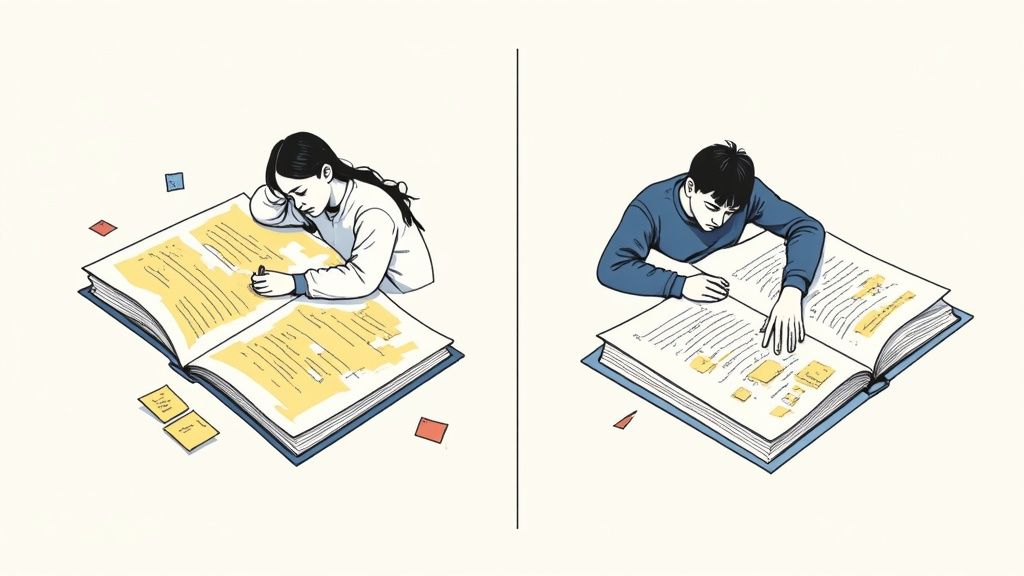
Before you dive headfirst into a new chapter, take a breath. The best way to tackle dense material isn't to just start at the beginning and plow through. What you need is a pre-reading ritual—a quick 15-minute reconnaissance mission to build a mental scaffold before the real work begins.
This isn’t just mindless skimming; it's a strategic preview. Think of it like looking at a map of a new city before you start driving. You spot the major highways, landmarks, and your final destination. That context makes the turn-by-turn directions make so much more sense. Your textbook chapter works the exact same way.
The Power of Creating a Mental Roadmap
Your brain loves connecting new information to stuff it already knows. A pre-reading survey gives it the framework to do just that. By getting a bird's-eye view first, you prime your mind for what’s important, which makes the actual reading process far more efficient and a lot less overwhelming.
Here’s how you can knock out a chapter survey in just 15 minutes:
- Read the Introduction and Conclusion First: These sections are pure gold. The intro tells you where the author is going, and the conclusion sums up the most critical points. You get the beginning and the end of the story right away.
- Scan Every Heading and Subheading: Seriously, read all of them. They form the chapter’s skeleton, showing you the logical flow of ideas and arguments from start to finish.
- Look for Visuals: Pay close attention to charts, graphs, diagrams, and photos. Their captions often summarize a key concept in a single glance, giving you another way to absorb the information.
- Spot the Bold and Italicized Terms: These are the vocabulary words and concepts the author is screaming at you to remember. Make a mental note—they're central to understanding everything else.
This quick flyover builds a map in your mind. Now, when you start reading for detail, you'll know exactly where each piece of information fits into the bigger picture.
The textbook itself is just a tool; how you use it determines its effectiveness. A 2019 study on math textbooks found their impact on student achievement was often small, with teacher quality and classroom practices playing a far more significant role. This underscores the need for active strategies, as just owning the book isn't enough. Find out more about these textbook effectiveness findings on edweek.org.
Turn Headings into Proactive Questions
This next part is the most powerful piece of the pre-reading ritual. You’re going to turn every heading into a question. It’s a simple trick, but it completely changes your mindset from passive reader to active investigator. Your brain is now officially on a mission to find answers.
For instance, a heading in your psychology textbook might say, "Classical Conditioning in Everyday Life." Don’t just read past it. Mentally rephrase it as a question: "What are some real-world examples of classical conditioning?"
Let’s try a couple more.
From a biology textbook:
- Original Heading: "The Role of Mitochondria in Cellular Respiration"
- Your Question: "What exactly do mitochondria do during cellular respiration?"
Or from a literature textbook:
- Original Heading: "Symbolism in The Great Gatsby"
- Your Question: "What are the key symbols in The Great Gatsby and what do they represent?"
This simple habit keeps you locked in and focused. You’re no longer just letting words wash over you; you’re on a hunt for specific information, which gives your reading a clear sense of purpose.
This same investigative mindset is what you need for deeper literary work, which you can read more about in our guide on how to write a literary analysis essay. By turning every section into a Q&A session with yourself, you guarantee you’re actually processing the material, not just letting your eyes glaze over the page. This is the foundation of studying a textbook effectively.
Mastering Notes That Actually Help You Learn
Mindless highlighting is the academic version of junk food. It feels productive at the moment, but it offers almost zero long-term benefit. If you really want to learn from a textbook, you need to turn its pages and your notebook into an active learning lab.
This whole process is less about creating a perfect transcript of the chapter and more about having a silent conversation with the author. You should be questioning their points, summarizing their arguments, and connecting the dots. The physical act of writing forces your brain to process information on a much deeper level than just letting your eyes glaze over the text.
Annotation That Fuels Understanding
Think of the margins of your textbook as your own private thinking space. This is where the real work gets done. Instead of just coloring in sentences that seem important, get your pen moving.
Here are a few ways I've learned to annotate with purpose:
- Summarize in the Margins: After reading a paragraph, can you boil it down to its core idea in five to ten words? Writing this little summary next to the paragraph is a great self-check to make sure you actually got it.
- Ask Critical Questions: Did the author make a claim you're skeptical of? Scribble "Why?" or "Evidence?" in the margin. Does a concept feel fuzzy? Jot down, "How does this connect to X from Chapter 2?"
- Draw Connections: Use arrows to link related ideas on the same page or make notes that call back to other chapters. Something like, "This is the opposite of Smith's theory from p. 45" is perfect.
This approach transforms the page from a static document into a dynamic record of your thought process. When it's time to review, you're not just rereading text; you're re-engaging with your own moments of clarity and confusion.
The Cornell Method for Structured Learning
Once you've marked up a section, it's time to get that knowledge into a more organized format. Hands down, one of the most effective systems ever designed for this is the Cornell Method. It’s so smart because it builds review right into the note-taking process itself.
Here’s how you set up your page:
- Divide Your Page: Just draw a big "I" on a sheet of paper. This gives you a main notes column on the right (about 6 inches), a smaller cue column on the left (about 2.5 inches), and a summary section at the bottom (about 2 inches).
- Take Notes: As you read, use the large right-hand column for your primary notes. Paraphrase concepts, write down formulas, and jot down key examples. Don't transcribe; keep it concise.
- Formulate Cues: Shortly after you finish reading, go back over your main notes. In the left-hand cue column, pull out keywords, potential test questions, and main ideas that correspond to the notes on the right. This is the crucial step where you really process what you wrote.
- Summarize: In that bottom section, write a one or two-sentence summary of the entire page's content. This forces you to synthesize everything at a high level.
When it's study time, you can cover the right column and use the cues on the left to quiz yourself. This active recall is dramatically more effective than just rereading your notes.
The ultimate goal of effective note-taking isn't just to record information, but to structure it for easy retrieval. The Cornell Method turns every page of notes into a built-in study guide, making your review sessions more focused and productive.
Concept Mapping for Visual Learners
For subjects where the relationships between ideas are more important than a straight line of facts—think biology, history, or philosophy—concept mapping can be a total game-changer. This visual technique helps you see the forest for the trees.
A concept map starts with one central idea and then branches out to show how other concepts relate to it.
Imagine you're tackling a history chapter on World War I. Your central bubble might be "Causes of WWI." From there, you could draw branches to major themes like:
- Militarism: Linked to sub-concepts like "Anglo-German Naval Race" and "New Military Technologies."
- Alliances: Connected to "Triple Entente" and "Triple Alliance," showing which nations were on each side.
- Imperialism: Branching out to "Scramble for Africa" and "Colonial Rivalries."
- Nationalism: Leading to points like "Balkan Powder Keg" and "Assassination of Archduke Ferdinand."
This method forces you to identify and understand the tangled web of connections within the material. It’s also a fantastic way to organize information that might be scattered throughout the textbook. This focus on practical connections is key.
Research shows that textbooks designed around real-world application significantly improve a student's ability to use what they've learned. A 2023 study found German textbooks, where 70% of exercises involved practical scenarios, were more effective at this than those with a purely theoretical focus. You can see more details from this comparative textbook analysis on eric.ed.gov.
Choosing the right note-taking system—whether linear like Cornell or visual like concept mapping—is a crucial step in learning how to study a textbook effectively.
Turn Your Notes into Powerful Review Tools
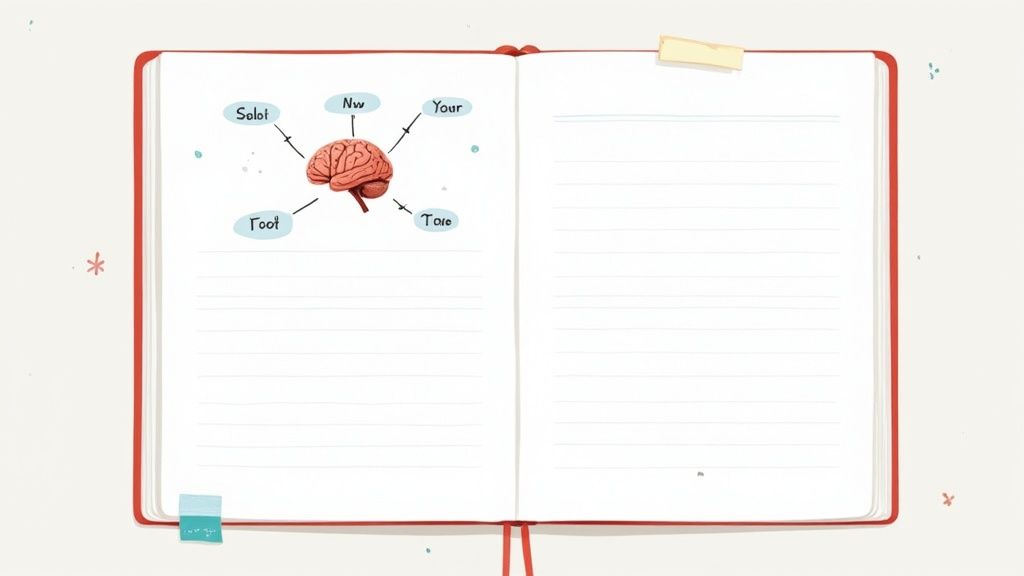
The real learning doesn't happen when you're reading. It happens when you try to remember what you just read. This is the simple but powerful idea behind active recall, and honestly, it's the most effective strategy I've ever seen for building long-term memory.
Instead of just rereading your highlights and notes, you need to force your brain to pull the information out from scratch. Think of it like this: the mental struggle to remember is what builds strong, lasting neural connections. It’s the brain's equivalent of lifting weights—the strain is what creates strength.
From Concepts to Questions
The easiest way to put this into practice is to convert every part of your notes into a question. This isn't about being clever; it’s a mindset shift. Your notes aren't a script to be memorized. They're raw material for your own personal exam.
Let's say you're studying cellular respiration in biology. You’ve jotted down the term "Glycolysis." Don't just stare at it. Turn it into a few pointed questions you can quiz yourself on later:
- What’s the main point of glycolysis?
- Where does it actually happen inside the cell?
- What goes in, and what comes out?
Do this for every key term, heading, and major idea in your notes. The process itself reinforces what you've learned, and what you're left with is a fantastic, custom-made study guide. If you're stuck, AI can help you find those core concepts. You can learn how to summarize a book or chapter with AI to quickly pinpoint the key ideas that are perfect for turning into questions.
The Power of Spaced Repetition
So, you have your questions. When do you actually review them? The worst answer is "the night before the exam." To truly master something, you have to use spaced repetition—a method where you review information at increasing intervals over time.
The whole point is to catch the memory just as you’re about to forget it. This process disrupts the brain’s natural “forgetting curve,” pushing the information deeper into your long-term memory with each review. Cramming for an exam is like trying to water a plant with a firehose; most of the information just runs off. Spaced repetition is like a slow, steady drip, ensuring everything gets absorbed.
This approach turns studying from a high-stress, one-time event into a continuous, low-stress cycle of reinforcement. It's about working smarter, not just cramming harder.
A Practical Spaced Repetition Schedule
Putting this into practice is simpler than it sounds. You don’t need any fancy software; a basic calendar or planner works perfectly.
Here’s a sample schedule you can adapt for any textbook chapter. This framework provides a clear, repeatable process for locking in what you learn.
Sample Spaced Repetition Schedule for a Textbook Chapter
| Review Session | When to Complete | Goal of the Session |
|---|---|---|
| First Review | Within 24 hours of taking notes. | Focus on clarifying and solidifying the main ideas. Answer your generated questions. |
| Second Review | 3 days after the first review. | Test yourself again. Spend extra time on questions you struggled with previously. |
| Third Review | 1 week after the second review. | Aim for quick recall. You should be able to answer most questions without much hesitation. |
| Fourth Review | 2-3 weeks after the third review. | This review locks the information into long-term memory. |
Following a system like this is how you truly master a textbook for knowledge that lasts. The evidence backs this up. A 2022 study on math students found that those who used their textbook daily scored 15% higher on average than infrequent users. Teacher guidance also played a huge role, with 65% of students being assigned textbook exercises.
You can delve into the full research on textbook usage and performance to see the data for yourself. By creating your own review schedule, you become your own guide, making sure you engage with the material deeply and often.
Using AI to Enhance Your Study Sessions
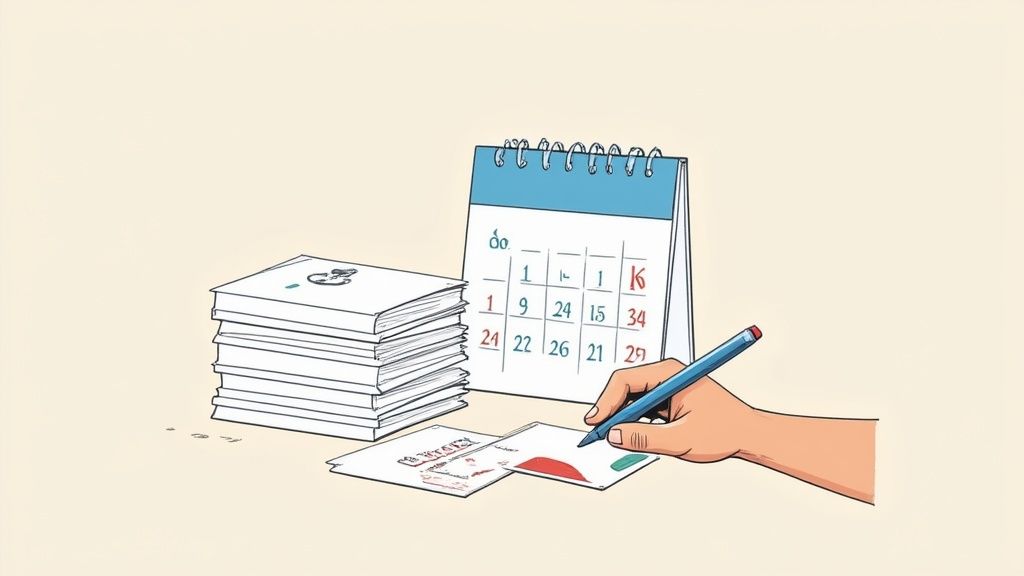
Let's be honest: all the active study methods we’ve covered take real effort. But what if you could work smarter, not just harder? This is where technology can give you a serious edge. Think of an AI study assistant as your personal, on-demand tutor, ready to go whenever you are.
The goal isn't to have the AI do the work for you. It’s about making your study time more interactive and productive. Tools like Feen AI can take a static, boring textbook page and turn it into a dynamic conversation, helping you find a fresh perspective when you're stuck on a dense paragraph.
Your AI-Powered Study Assistant
We've all been there. You're staring at a brutal page in your physics or philosophy textbook, you've read it three times, and the concepts still feel like a foreign language. That’s the perfect time to call in some backup.
Instead of banging your head against the wall, you can just snap a picture of the page or upload a PDF. From there, you can tell the AI exactly what you need to make the material click. This transforms a frustrating, passive reading session into an active, engaging one.
Here are a few ways I’ve seen students use this effectively:
- Simplify the jargon: Ask it to re-explain something in plain English. For example, "Explain the theory of relativity from this page as if I'm a high school student."
- Find the main idea: When you can't see the forest for the trees, ask, "Summarize the key arguments from this text in three bullet points."
- Create helpful analogies: For really abstract concepts, a good comparison can make all the difference. Try a prompt like, "Give me a real-world analogy to help me understand mitochondrial function from this chapter." That's often where the "aha!" moment happens.
The clean, chat-style interface makes it feel natural to ask follow-up questions and really dig into the material you've uploaded, almost like you're texting a subject-matter expert.
Generate Practice Questions on Demand
This is where AI becomes a real game-changer for your study routine. Its ability to create practice questions straight from your textbook is amazing for active recall and self-testing. You're no longer just hoping you understood a chapter—you can prove it to yourself instantly.
Finished the chapter on the Krebs cycle in your biology textbook? Don't just close the book. You could ask your AI assistant:
- "Generate five multiple-choice questions about the Krebs cycle based on this text."
- "Create three short-answer questions that would be fair game for an exam on this section."
- "Make me a few flashcards with key terms and definitions from this page."
This simple shift from passive reading to active practice is where deep learning kicks in. In fact, one study showed that students using an AI-augmented learning tool scored 11% higher on retention tests than those who just used a standard digital reader.
This kind of on-the-fly quizzing helps you find your weak spots immediately. Get a question wrong? You know exactly what paragraph to go back and reread. It makes your review sessions incredibly efficient.
How to Use AI Ethically and Effectively
It's really important to approach these tools with the right mindset. They are assistants, not cheat codes. The whole point is to deepen your own understanding, not to skip the learning process.
Here’s a simple framework I tell students to follow:
- Clarify, Don’t Copy: Asking an AI to explain a concept in a new way is smart studying. Asking it to write your essay is academic dishonesty. Simple as that.
- Focus on Practice and Review: Use these tools to generate quizzes, flashcards, and summaries that reinforce what you've already learned through your own reading and note-taking.
- Always Double-Check: AI is powerful, but it’s not perfect. If an explanation or answer seems a little off, trust your gut. Cross-reference it with your textbook or ask your instructor.
When you treat AI as a dedicated study partner, you can make your learning sessions more efficient, interactive, and tailored to your specific needs. It's just one more powerful tool in your active study toolkit to help you conquer even the toughest material.
Navigating the Inevitable Study Roadblocks
Even with the best strategies, you're going to hit a wall. It’s inevitable. Some textbooks are just brutally dense, others are poorly written, and the distractions of modern life are always ready to pull you away. Knowing how to troubleshoot these common issues is just as crucial as knowing how to take good notes in the first place.
When you feel your focus slipping, don't just try to power through with sheer willpower. That's a recipe for burnout. Instead, give yourself a better framework. The Pomodoro Technique is a classic for a reason: you work in focused 25-minute sprints followed by a 5-minute break. This simple rhythm makes a daunting chapter feel much less intimidating.
If you consistently find yourself fighting distractions or struggling to stick to a schedule, it might be time for a more structured approach. Learning about effective time blocking for focus can give you a concrete system for carving out dedicated time for deep work, which helps keep you from getting sidetracked.
Wrestling with Difficult Material
So, what do you do when the textbook itself is the problem? You've read a page three times and the words still feel like a meaningless jumble. This is a common frustration, especially in technical fields.
First things first: don't be afraid to step outside the assigned reading. Your textbook is a tool, not the only source of knowledge on the planet.
- Look for Videos: Head to YouTube. Channels like Khan Academy or The Organic Chemistry Tutor have saved countless students from confusing explanations. Seeing a concept explained visually can make all the difference.
- Find Another Book: Go to the library and check out a different textbook on the same subject. Sometimes, just hearing another author explain the same idea from a new angle is all it takes for a difficult concept to finally click.
The real goal is to understand the material, not to heroically conquer one specific, poorly-written book. Being resourceful is a key part of effective studying.
Why You Shouldn't Always Study Alone
Studying doesn't have to be a solo mission. When you're really stuck, a small study group can be an absolute game-changer. There's a certain magic to explaining a concept to someone else—it's one of the fastest ways to find the gaps in your own understanding.
Just make sure you set a clear agenda for your sessions. This isn't just a social hangout. Agree beforehand to tackle a specific chapter or a set of practice problems. You can even have each member take turns teaching a concept to the group. This mix of collaboration and accountability will help everyone push through the toughest parts of any course.
Common Questions About Studying from Textbooks
Even with the best game plan, you're bound to run into a few hurdles when you're deep in a textbook. Let's tackle some of the most common questions I get asked.
How Long Should I Actually Spend on a Single Chapter?
There's no universal answer here, and anyone who gives you one is guessing. The time you need really depends on the class and how familiar you are with the material.
A great starting point is time blocking. Set aside a dedicated, focused chunk of time—maybe 90 minutes—and just see how far you get.
For a beast of a subject like organic chemistry, you might only make it through a few pages in that time. But for something like an intro to psychology chapter, you could sail right through it. The real goal isn't speed; it's the quality of your focus during that block. Get a feel for the course and adjust your time blocks from there.
The Million-Dollar Question: Handwriting or Typing Notes?
This debate is as old as the laptop, and honestly, both sides have a point. Studies have shown that physically writing notes can help you understand concepts on a deeper level. Why? Because it's slow. It forces your brain to paraphrase and condense ideas instead of just transcribing them.
On the other hand, you can't beat digital notes for organization. Being able to search, edit, and rearrange them is a huge advantage. So, why not get the best of both worlds? Try a hybrid method: jot down your initial messy notes by hand during your first pass, then type them up into a clean, organized document later. You get the cognitive boost of writing plus the long-term benefit of searchable notes.
At the end of the day, the best note-taking system is the one you actually stick with. Whether it's a pen or a keyboard, the goal is the same: to turn passive reading into an active conversation with the text.
What if My Textbook Is 100% Digital?
Digital textbooks can be a double-edged sword. They come with cool features but also a universe of distractions just a click away. The key is to use their tools to your advantage. Get comfortable with the built-in highlighters and annotation features.
One of the most effective setups I've seen is a simple split-screen view. Keep your textbook open on one side of the screen and your digital notebook on the other. This little trick helps you mimic the natural flow of reading and taking notes without constantly switching windows. And to fight the temptation of social media, use a browser extension to block distracting sites during your study blocks.
Feeling stuck on a particularly dense page? Feen AI is perfect for that. Just snap a picture of any textbook page, and you can get instant summaries, practice questions, and easy-to-understand explanations. Make your next study session way more productive at https://feen.ai.
Recent articles
Discover what is hypothesis testing in statistics and how it works, with clear steps, core concepts, and practical examples to draw valid conclusions from data.
Learn how to factor polynomials completely using our guide. From GCF to advanced methods, we'll help you solve any algebra problem with confidence.
A practical guide on how to solve matrix equations. Master Gaussian elimination, matrix inverses, and Cramer's Rule with clear examples and expert tips.
A complete guide to the copper hydroxide formula (Cu(OH)₂). Learn how to derive it, its key properties, practical uses, and safety.
Discover rhetorical device examples to elevate your writing. Learn practical figures of speech like alliteration, metaphor, and irony to engage readers.
Discover the empirical formula for ascorbic acid (C₃H₄O₃) with this clear, step-by-step guide. We break down the chemistry behind Vitamin C's simplest ratio.
